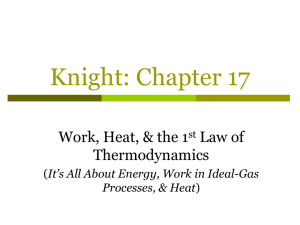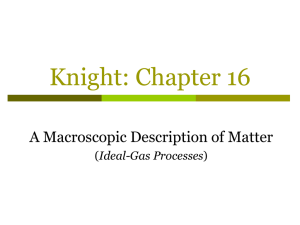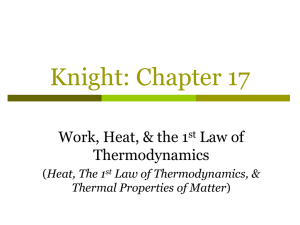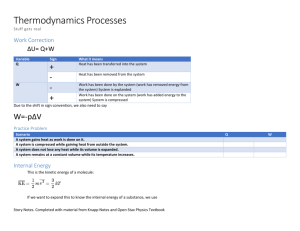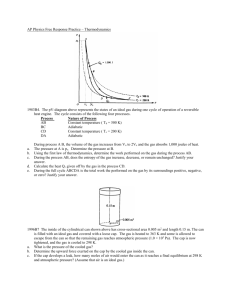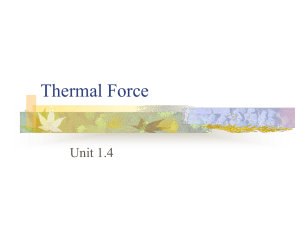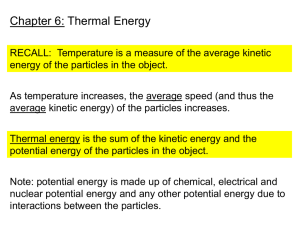chapter17.1 - Colorado Mesa University
advertisement
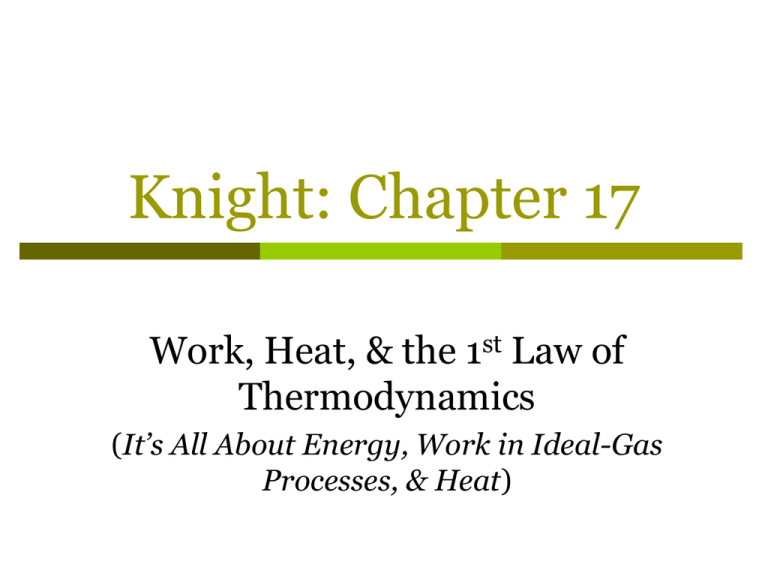
Knight: Chapter 17 Work, Heat, & the 1st Law of Thermodynamics (It’s All About Energy, Work in Ideal-Gas Processes, & Heat) Energy review… The work-kinetic energy theorem is… Energy review… The total energy of a system consists of the macroscopic energy + the microscopic thermal energy. Notice: The total energy of an isolated system, when Wext = 0, is constant. Energy transfer by Work Doing work on a system increases its energy! Lifting a block with a rope at a steady speed. The tension is an external force doing work Wext. Energy transferred into the system goes entirely into the macroscopic potential energy, Ugrav. Dragging a block with a rope at a steady speed. The tension is an external force doing work Wext. Energy transferred into the system goes entirely into the thermal energy of the object + surface system, Eth. Energy transfer by Heat Work, W, is energy transferred in a mechanical interaction. Heat, Q, is energy transferred in a thermal interaction. The complete energy equation is… Quiz Question 1 A steady force pushes in the piston of a well-insulated cylinder. In this process, the temperature of the gas 1. 2. 3. 4. increases. stays the same. decreases. There’s not enough information to tell. Work in Ideal-Gas Processes Consider a gas cylinder sealed at one end by a movable piston… The external force does work on the gas as the piston moves. Work in Ideal-Gas Processes Consider a gas cylinder sealed at one end by a movable piston… The external force does work on the gas as the piston moves. Notice: The sign of the work is NOT an arbitrary convention, nor does it have anything to do with the choice of coordinate system. Work in Ideal-Gas Processes On a pV diagram, the work done on a gas, W, has a nice geometric interpretation… W = the negative of the area under the pV curve between Vi and Vf. Quiz Question 2 Three possible processes A, B, and C take a gas from state i to state f. For which process is the magnitude of the work the largest? 1. 2. 3. 4. Process A. Process B. Process C. The work is the same for all three. Problem-Solving Strategy Work Done on an Ideal Gas… In an isochoric process, the work done on the gas is… Work Done on an Ideal Gas… In an isobaric process, the work done on the gas is… Work Done on an Ideal Gas… In an isothermal process, the work done on the gas is… Work Done on an Ideal Gas… In an isothermal process, the work done on the gas is… i.e. 17.2: The Work of an Isothermal Compression A cylinder contains 7.0 g of nitrogen gas. How much work must be done to compress the gas at a constant temperature of 80°C until the volume is halved? Work in Ideal-Gas Processes… Figure (a) shows 2 different processes that take a gas from an initial state i to a final state f. Notice: • The work done during an ideal-gas process depends on the path followed through the pV diagram. • During the multistep process of figure (b), the work done is NOT the same as a process that goes directly from 1 to 3. Work in Ideal-Gas Processes… In the 1840s, James Joule showed that heat and work, are simply two different ways of transferring energy to or from a system. The final state of H2O is exactly the same in both cases! Heat, Temperature, and Thermal Energy Thermal energy, Eth… • is an energy of the system due to the motion of its atoms and molecules. Heat, Q… • is energy transferred between the system and the environment as they interact. Temperature, T… • is a state variable that quantifies the “hotness” or “coldness” of a system. A temperature difference is required in order for heat to be transferred between the system and the environment.
